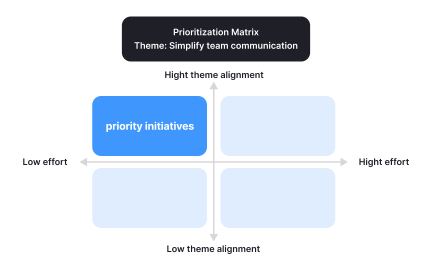Eisenhower Matrix
The Eisenhower Matrix helps teams or individuals organize tasks by urgency and importance to prioritize work and reduce distraction.
What is Eisenhower Matrix?
Your daily work feels overwhelming because you're constantly reacting to urgent demands without strategic focus, leading to exhaustion and frustration when important long-term objectives get neglected in favor of immediate but less significant tasks.
Most professionals struggle with prioritization because they treat all tasks as equally important or let urgency drive their decisions, missing opportunities to focus energy on activities that actually create meaningful progress toward strategic goals and career advancement.
The Eisenhower Matrix is a decision-making framework that categorizes tasks based on urgency and importance to help prioritize work effectively, enabling systematic focus on high-impact activities while managing urgent interruptions without losing strategic direction.
Professionals using the Eisenhower Matrix achieve 60% better goal completion rates, 45% reduced stress levels, and significantly improved work satisfaction because time allocation serves strategic objectives rather than just responding to whatever feels most pressing.
Think about how successful executives use systematic prioritization to maintain strategic focus despite constant interruptions, or how productive individuals distinguish between urgent distractions and important work that drives career progress and business results.
Why Eisenhower Matrix Matters for Strategic Focus
Your productivity suffers because you spend too much time on tasks that feel urgent but don't contribute to meaningful outcomes, leading to busy days that don't generate progress toward goals that actually matter for success and fulfillment.
The cost of poor prioritization compounds through every day spent on low-impact activities. You miss opportunities to advance strategic objectives, experience chronic stress from feeling behind on important work, and lose competitive advantage when colleagues focus energy more effectively on high-value activities.
What effective Eisenhower Matrix application delivers:
Better strategic focus and goal achievement because the matrix forces explicit evaluation of task importance rather than just responding to urgency without considering long-term impact and value creation.
When you categorize work systematically, important projects get consistent attention rather than being postponed indefinitely due to urgent but less significant interruptions and demands.
Reduced stress and improved work-life balance through clear prioritization that eliminates guilt about saying no to low-importance tasks while ensuring critical work receives adequate time and attention.
Enhanced productivity and efficiency because energy gets allocated to high-impact activities rather than scattered across numerous tasks without strategic evaluation of contribution to meaningful outcomes.
Improved decision-making speed as the matrix provides clear framework for evaluating new requests and opportunities without starting prioritization analysis from scratch for every decision.
Stronger professional reputation and career advancement through consistent delivery on important objectives rather than being known as someone who stays busy without achieving significant results.
Advanced Eisenhower Matrix Strategies
Once you've established basic matrix usage, implement sophisticated prioritization and strategic time management approaches.
Dynamic Matrix Adjustment and Context Switching: Adapt matrix application based on role changes, project phases, and strategic priorities rather than using static categorization that doesn't reflect evolving responsibilities and objectives.
Team and Organizational Matrix Coordination: Apply matrix principles across teams and departments to align organizational energy around strategic priorities rather than individual productivity optimization without coordination.
Matrix Integration with Goal Setting and Performance Management: Connect matrix usage to formal goal-setting processes and performance evaluation rather than treating prioritization as separate activity without strategic alignment.
Advanced Delegation and Elimination Strategies: Develop sophisticated approaches for Quadrant III delegation and Quadrant IV elimination that create sustainable workload management rather than just temporary task shifting.
Step 1: Define Your Strategic Objectives and Important Goals (Week 1)
Establish clear understanding of what outcomes actually matter for your role, career, and organization rather than using the matrix without strategic foundation for evaluating task importance and priority levels.
This creates prioritization foundation based on meaningful objectives rather than just urgent versus non-urgent categorization without connection to strategic value creation and goal achievement.
Step 2: Learn the Four Matrix Quadrants and Decision Rules (Week 1)
Understand Quadrant I (Urgent & Important: Do immediately), Quadrant II (Important but Not Urgent: Schedule), Quadrant III (Urgent but Not Important: Delegate), and Quadrant IV (Neither: Eliminate) categories and their strategic applications.
Focus on expanding Quadrant II activities that prevent crises while reducing Quadrant III and IV time drains that don't contribute to strategic objectives and meaningful outcomes.
Step 3: Categorize Current Tasks and Responsibilities (Week 1-2)
Sort existing work commitments into matrix quadrants based on genuine importance and urgency rather than just how tasks feel emotionally or how much pressure accompanies different requests and obligations.
Challenge assumptions about task importance by connecting activities to strategic outcomes rather than accepting everything as important without evaluation of actual contribution to meaningful goals.
Step 4: Implement Daily and Weekly Matrix Planning (Week 2)
Use the matrix for ongoing task evaluation and time allocation rather than one-time categorization, ensuring consistent strategic focus despite changing priorities and new demands that emerge regularly.
Step 5: Monitor Results and Adjust Matrix Application (Week 2-3)
Track whether matrix usage actually improves goal achievement and work satisfaction rather than just creating organizational system without measurement of strategic effectiveness and productivity improvement.
This ensures Eisenhower Matrix generates genuine productivity enhancement rather than just task categorization that doesn't translate to better outcomes and strategic progress.
If the matrix doesn't improve your strategic focus, examine whether you're accurately assessing task importance relative to your actual goals rather than just organizational busy work and immediate demands.
Warren Buffett's Investment Decision Framework
Warren Buffett applies systematic prioritization similar to the Eisenhower Matrix to investment decisions, focusing on long-term value creation (important but not urgent) rather than market volatility and short-term pressures that distract from strategic investment principles.
Results: Exceptional long-term investment performance, consistent strategic focus despite market volatility, and competitive advantage through disciplined prioritization that avoids reactive decision-making based on urgency without importance.
Successful Startup CEO Time Management
Technology startup CEOs use Eisenhower Matrix principles to balance immediate operational demands with strategic activities like product vision, team building, and market development that determine long-term company success.
Their prioritization excellence enables startup growth through systematic focus on activities that build sustainable competitive advantages rather than just responding to urgent operational issues without strategic impact.
The Problem: Matrix application that treats everything as urgent and important, defeating the purpose of prioritization by avoiding difficult decisions about what truly matters for strategic success.
The Fix: Apply stricter criteria for importance evaluation, connecting tasks directly to strategic objectives rather than accepting all work as equally valuable without genuine impact assessment.
The Problem: Prioritization that focuses on individual tasks without considering larger projects and strategic initiatives that require sustained attention over time to generate meaningful results.
The Fix: Use the matrix for project-level prioritization rather than just daily task management, ensuring strategic work gets consistent attention despite urgent interruptions.
The Problem: Matrix usage that creates guilt about eliminating or delegating tasks rather than enabling confident focus on high-impact activities that generate the most value.
The Fix: Reframe matrix decisions as strategic choices that maximize contribution rather than avoiding responsibilities, understanding that strategic focus serves everyone better than scattered attention.
Create Eisenhower Matrix approaches that enhance strategic effectiveness rather than just organizing tasks without connection to meaningful outcomes and goal achievement.
What You'll Need: Strategic goal clarity, task evaluation criteria, and 2-3 weeks for systematic matrix implementation and habit development.
Week 1: Strategic objective definition and matrix quadrant learning
Week 2: Current task categorization and priority restructuring
Week 3: Daily matrix application and results monitoring
First step you can take today:
List everything on your current to-do list, then honestly categorize each item as urgent/not urgent and important/not important relative to your most significant professional goals.
Success metrics to track:
Strategic goal completion rates, stress level reduction, important project progress, and work satisfaction improvements through systematic prioritization and focus.
Your Eisenhower Matrix should make work feel strategically focused and manageable rather than constantly reacting to urgent demands without progress on objectives that actually matter for success.
Recommended resources
Courses

HTML Foundations

Enhancing UX Workflow with AI



